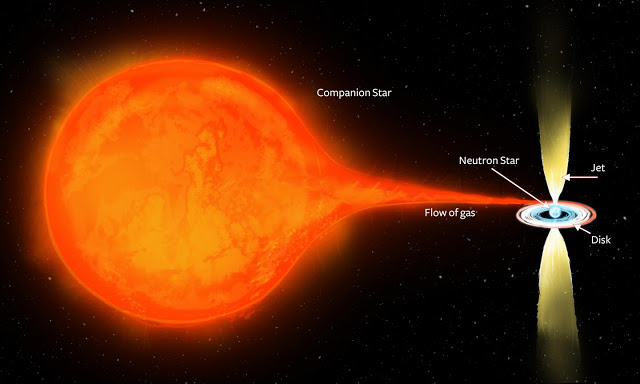| Online: | |
| Visits: | |
| Stories: |

| Story Views | |
| Now: | |
| Last Hour: | |
| Last 24 Hours: | |
| Total: | |
Companion Star and Neutron Star Blasting Powerful Jets
In a study published today, a team of scientists in the Australia and the Netherlands has discovered powerful jets blasting out of a double star system known as PSR J1023+0038.This is an annotated artist’s impression of the binary star system PSR J1023+0038. An ultra-dense neutron star pulls gas from its companion, launching jets powerful enough to rival those from black holes.
It was previously thought that the only objects in the Universe capable of forming such powerful jets were black holes.
PSR J1023+0038 contains an extremely dense type of star astronomers call a neutron star, in a close orbit with another, more normal star nearby.
It was first identified as a neutron star in 2009 but it was only when the research team observed the star with the Very Large Array radio telescope in the United States in 2013 and 2014 that they realised the star was producing much stronger jets than expected.
Astronomer James Miller-Jones, from the Curtin University node of the International Centre for Radio Astronomy Research (ICRAR), says neutron stars can be thought of as stellar corpses.
“They’re formed when a massive star runs out of fuel and undergoes a supernova, and the central parts of the star collapse under their own gravity,” he says.
“These things are typically about one and a half times the mass of the Sun and yet they’re only 10-15km across, so they’re incredibly dense.”
ASTRON astronomer Adam Deller, who led the research, says neutron stars and black holes are sometimes found in orbit with a nearby “companion” star.
“Gas can then flow from the companion star to the neutron star or black hole, producing spectacular displays when some of the material is blasted out in powerful jets at close to the speed of light,” he says.
“From what we had seen previously, black holes were previously considered the undisputed kings of forming powerful jets, even when they were only fed by a little bit of material from their companion star.”
“In comparison, neutron stars seemed to make relatively puny jets, which only became bright enough to see when the neutron stars were gobbling gas from their companions at a very high rate.”
Dr Deller says when the team looked at PSR J1023+0038 it was only consuming a trickle of material and should have been producing a very feeble jet.
“But our observations suggest its jets are nearly as strong as you’d expect from a black hole,” he says.
Dr Miller-Jones says PSR J1023+0038 is a “transitional” neutron star, spending years at a time powered mainly by the rotation of the neutron star but transitioning occasionally into an active gathering state, when it gets much brighter.
“Two other transitional systems are now known and both of these have also been shown to exhibit powerful jets,” he says.
“This is casting neutron stars in a new light and showing that in fact they can sometimes launch jets to rival those coming from black holes.”
The research was published today in the Astrophysical Journal.
Pete Wheeler
Source:




